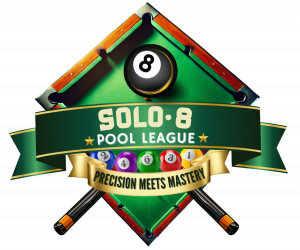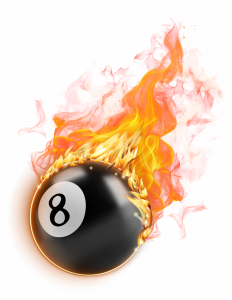1. OBJECT OF THE GAME.
Eight Ball is a call shot game played with a cue ball and fifteen object balls, numbered 1 through 15. One player must pocket balls of the group numbered 1 through 7 solid colors, while the other player has 9 thru 15 stripes. THE PLAYER POCKETING HIS GROUP FIRST AND THEN LEGALLY POCKETING THE 8 BALL WINS THE GAME.
2. CALL SHOT.
In Call Shot, obvious balls and pockets ARE TO BE indicated. If your opponent is unsure of the shot it can result in “ball in hand”. Bank shots and combination shots are to be called as well, Care should be taken in calling both the object ball and the intended pocket. When calling the shot, it is NEVER necessary to indicate details such as the number of cushions, banks, kisses, caroms, etc. Any balls pocketed on a foul remain pocketed, regardless of whether they belong to the shooter or the opponent.
The opening break is not a called shot. Any player performing a break shot in 8 Ball may continue to shoot his next shot so long as he has legally pocketed any object ball on the break.
3. RACKING THE BALLS.
The balls are racked in a triangle at the foot of the table with the 8 ball in the center of the triangle, the first ball of the rack on the foot spot, a stripe ball in one corner of the rack and a solid ball in the other corner.
4. ALTERNATING BREAK. Winner of the lag has the option to break. During individual competition, players will alternate breaking on each subsequent game.
5. JUMP AND MASSE SHOT FOUL.
All ball fouls is the rule of play, therefore a player should be aware that it will be considered a cue ball foul if during an attempt to jump, curve or masse the cue ball over or around an impeding numbered ball that is not a legal object ball, the impeding ball moves, it is considered a foul, regardless of whether it was moved by a hand, cue stick, follow through or bridge.
6. LEGAL BREAK SHOT.
Defined. To execute a legal break, the breaker with the cue ball behind the head string, must either 1, pocket a ball, or 2, drive at least four numbered balls to the rail. If he fails to make a legal break, it is a foul, and the incoming player has the option of 1 accepting the table in position and shooting, or 2, having the balls reracked and having the option of shooting the opening break himself or allowing the offending player to rebreak.
7. SCRATCH ON A LEGAL BREAK.
1.If a player scratches on a legal break shot, 1, all balls pocketed remain pocketed, exception, the 8 ball: see rule 9, 2. it is a foul, 3. The table is open. PLEASE NOTE, Incoming player has cue ball in hand behind the head string and may not shoot an object ball that is behind the head string, unless he first shoots the cue ball past the head string and causes the cue ball to come back behind the head string and hit the object ball.
8. OBJECT BALLS JUMPED OFF THE TABLE ON THE BREAK.
If a player jumps an object ball off the table on the break shot, it is a foul and the incoming player has the option of 1, accepting the table in position and shooting, or 2, taking cue ball in hand behind the head string and shooting.
9. 8 BALL POCKETED ON THE BREAK.
If the 8-ball is pocketed on the break while the cue ball remains on the table, It is considered a WIN. If the breaker scratches on the cue ball and pockets the 8 ball on the break, It is considered a loss of game.
10. OPEN TABLE.
Defined. The table is open when the choice of groups, stripes or solids, has not yet been determined. When the table is open, it is legal to hit a solid first to make a stripe or vice-versa. COMBINATION IS NOT ALLOWED WITH THE 8 BALL. If the 8-ball is contacted in the process of pocketing the called stripe or solid. no stripe or solid may be scored in favor of the shooter. The shooter loses his turn and any balls pocketed remain pocketed, and the incoming player addresses the balls / table with ball in hand. The table is still open. On an open table, all illegally or illegally pocketed balls remain pocketed.
11. CHOICE OF GROUP.
The choice of stripes or solids is not determined on the break even if balls are made from only one or both groups. THE TABLE IS ALWAYS OPEN IMMEDIATELY AFTER THE BREAK SHOT. The choice of group is determined only when a player legally pockets a called object ball after the break shot.
12. LEGAL SHOT.
Defined. On all shots except on the break and when the table is open, the shooter must hit one of his group of balls first and 1, pocket a numbered ball, or 2, cause the cue ball or any numbered ball to contact a rail.
PLEASE NOTE: It is permissible for the shooter to bank the cue ball off a rail before contacting his object ball. However, after contact with his object ball, an object ball must be pocketed, Or the cue ball or any numbered ball must contact a rail. Failure to meet these requirements is a foul.
13. SAFETY SHOT.
For tactical reasons a player may choose to use his numbered ball to pocket the opponent’s ball (combination) and also discontinue his turn at the table by declaring safety in advance. A safety shot is defined as a legal shot. If the shooting player intends to play safe by using their ball and pocketing the opponent’s ball, then prior to the shot, he must declare a safety to his opponent. If this is NOT done, If the shooter called safety prior to the shot and the shooter’s ball was pocketed, then it’s up to the opponent to shoot or return the shot to the original shooter. Any ball pocketed on a safety shot remains pocketed.
14. SCORING.
A player is entitled to continue shooting until he fails to legally pocket a ball of his group. After a player has legally pocketed all of his group of balls, he shoots to pocket the 8 ball.
15. FOUL PENALTY.
Opposing player gets the cue ball in hand. This means that the player can place cue ball anywhere on the table, and does not have to be behind the head string except on the opening break. This rule prevents a player from making intentional fouls which would put his opponent at a disadvantage. With cue ball in hand, the player may use his hand or any part of his cue except the tip to position the cue ball. When placing the cue ball in position, any forward stroke motion contacting the cue ball or any ball will be a foul. ALL BALL FOUL
16. COMBINATION SHOTS.
Combination shots are allowed. However, the 8 ball cannot be used in any combination.
17. ILLEGALLY POCKETED BALLS.
An object ball is considered to be illegally pocketed when 1, that object ball is pocketed on the same shot a foul is committed, or 2, the called ball did not go in the designated pocket, or 3, a safety is called prior to the shot. Illegally pocketed balls remain pocketed.
18. OBJECT BALLS JUMPED OFF THE TABLE.
If any object ball is jumped off the table, it is a foul and loss of turn, unless it is the 8 ball, which is a loss of game. Any jumped object balls are spotted in numerical order according to General Rules for spotting balls.
19. PLAYING THE 8 BALL.
When shooting at the 8 ball, a scratch or foul is a loss of game. If the 8 ball jumped from the table it’s a loss of game. A combination shot can never be used to legally pocket the 8-ball.
20. LOSS OF GAME.
A player loses the game if he commits any of the following infractions:
a. Fouls when pocketing the 8 ball. Exception. See 8-Ball Pocketed On the Break.
b. Pockets the 8 ball on the same stroke as the last of his group of balls.
c. Jumps the 8 ball off the table at any time.
d. Pockets the 8 ball in a pocket other than the one designated.
e. Pockets the 8 ball when it is not the legal object ball.
Note: All infractions must be called before another shot is taken, or else it will be deemed that no infraction occurred.
21. STALEMATED GAME.
If, after 3 consecutive turns at the table by each player, 6 turns total, the referee judges or if no referee, both players agree, that attempting to pocket or move an object ball will result in loss of game, the balls will be reracked with the original breaker of the stalemated game breaking again. The stalemate rule may only be used when there are only two object balls and the 8 ball remaining on the table. PLEASE NOTE, Three consecutive fouls by one player is not a loss of game.
22. REMOVING BALLS.
When a lower skilled player competes against a higher skilled player, the lower skilled player has the option to remove up to four balls from the table during their first legal turn. This option can only be exercised during their initial turn. For more details, See Scoring Chart.
23. FORFEITS.
The Solo 8 Pool League does not recognize forfeits as a valid outcome of a match. All scheduled matches are expected to be completed in the spirit of fairness and competition. If a player prematurely ends a match or writes “forfeit” on the score sheet, the league operator will determine the appropriate resolution. The following options may be applied at the league’s discretion:
1. Split the Points – The total 10 points will be divided.
2. Replay the Match – Both players may be required to replay the match at a later date.
3. Phantom Player Substitution – If resolution cannot be achieved or one party is uncooperative, the match may be replaced with a phantom player. Points will be assigned based on league discretion, taking into account fairness and consistency with scoring standards.
NOTE :
• A no-call/no-show results in a -5 point penalty.
• A completed match where a player loses earns them +5 points.
• Reaching the hill (one game away from winning) earns 8 points, and a win earns 10 points.
This policy ensures that points are awarded based on effort, communication, and sportsmanship — not on forfeits.
NOTE :
As this is a newly established league, rules and policies may be adjusted or refined in response to real-world situations and player experiences. All changes will be made with the intent of promoting fairness, clarity, and a smooth, enjoyable league experience for everyone involved.



